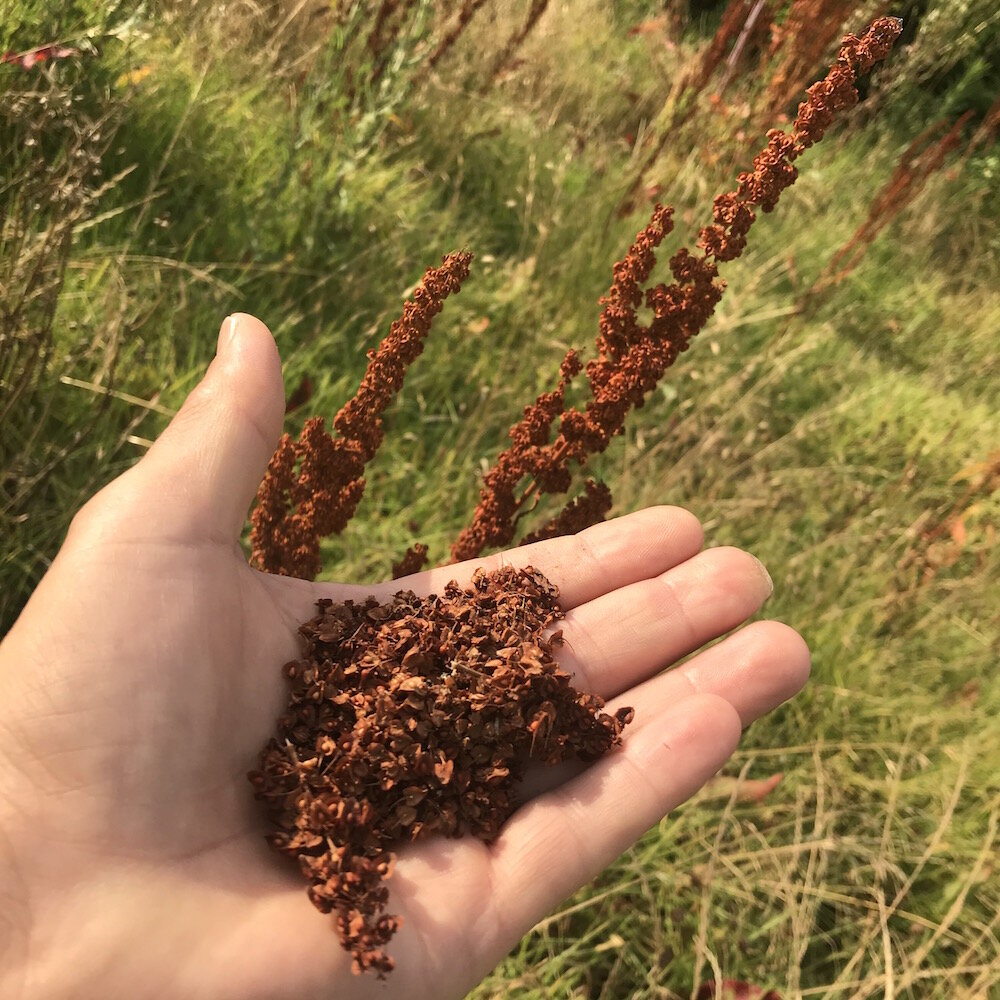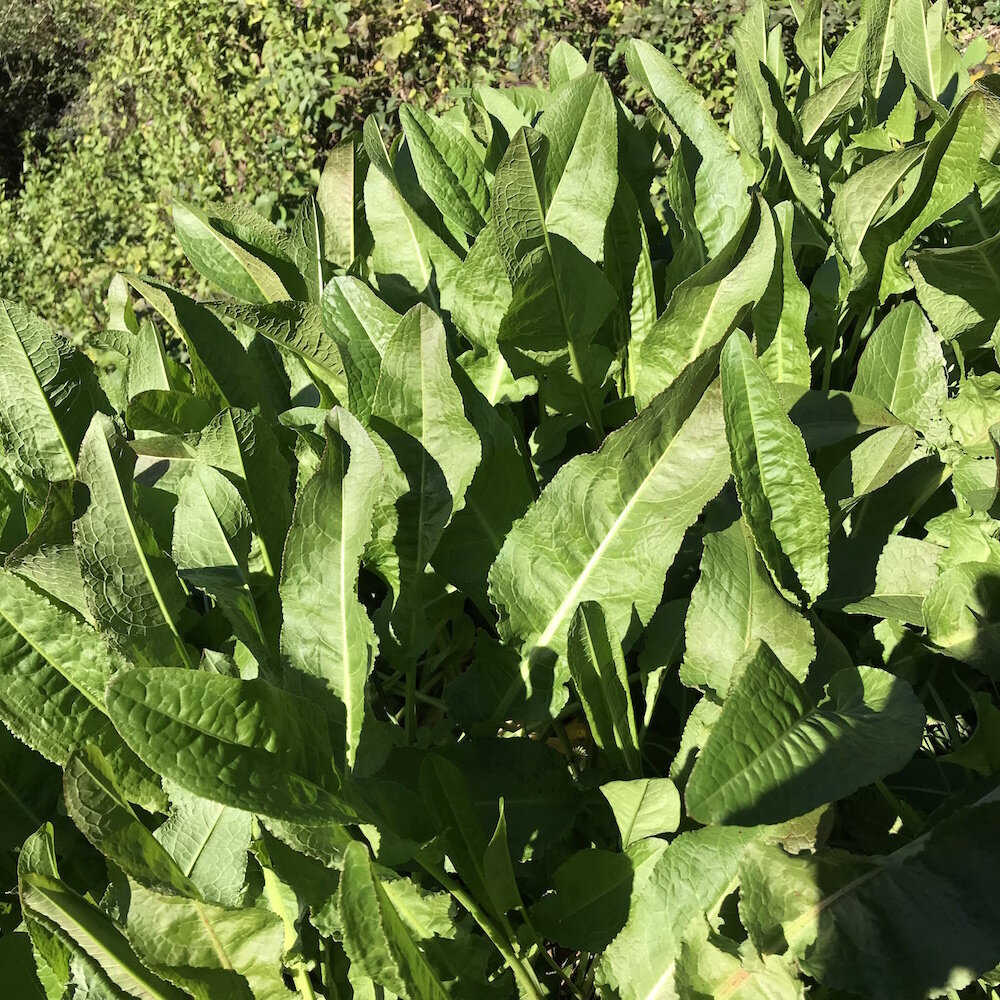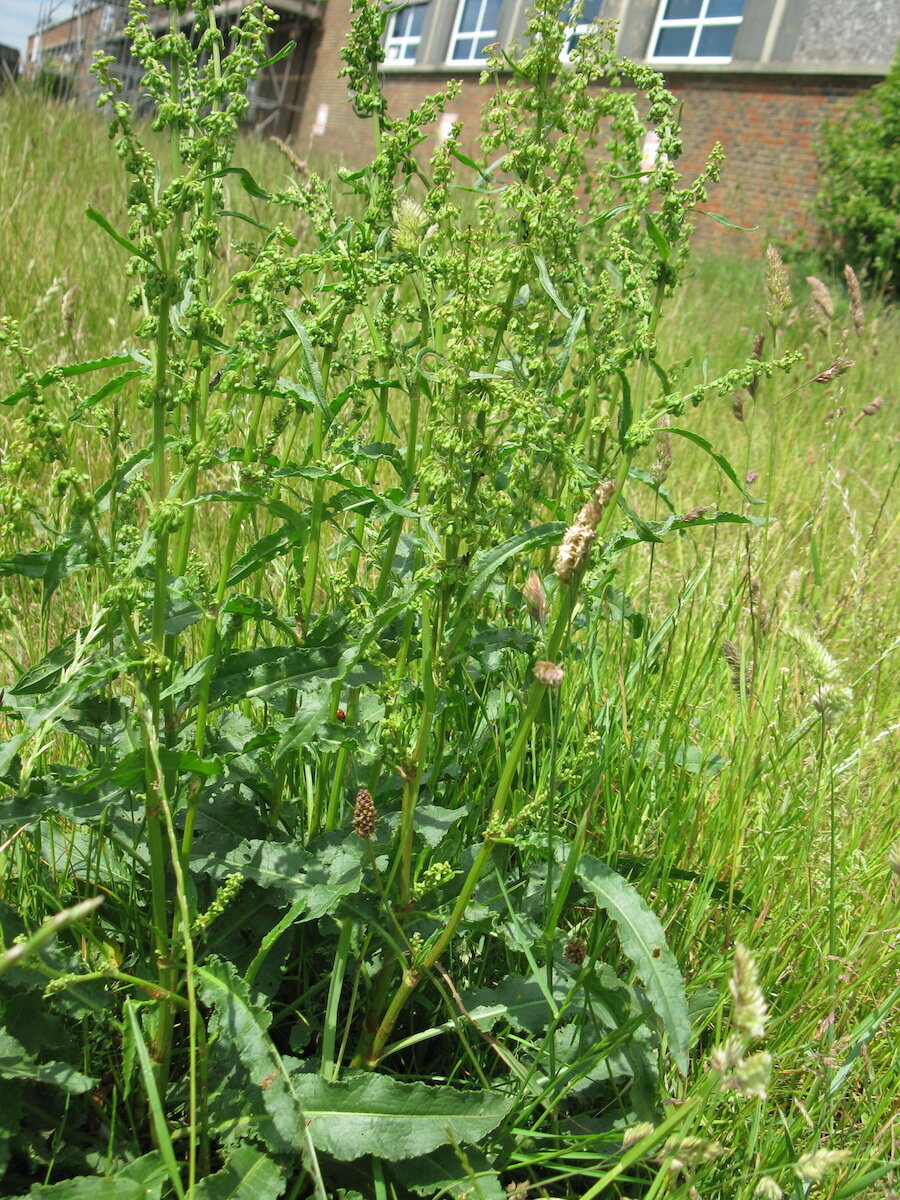How to identify and use yellow dock and its close relatives
I remember as a young boy following my mum through the fields to do the seasonal jobs. We used to spend hours in the fields, in the sun, irrigating or cropping, harvesting or tending to the pastures. As young kids, my sisters and I would run around a lot, chase insects and butterflies; poke sticks in little rodent’s hollows or stalk frogs in the ditches. I distinctively remember times being hungry and thirsty and my mum would turn the attention off her task, look at me briefly, walk to the irrigation channels, pull up a leaf or two of lavasoj and pronounce: we’re nearly done, eat this, be quiet.
Lavasoj is the Piedmontese name for yellow dock (Rumex crispus). It was and still is a common weed in pastures in northern Italy as much as the rest of the world.
I remember eating the stalk as the leaves were often too dry and bitter, but the stalk was juicy, tart and buttery. And off I went distracted again by a ladybug or a grasshopper.
I still eat dock’s stalks, from the young leaves in the middle of the plants, when they are still viscous with mucilage from the central growth. I still harvest them straight from the fields and relive that flavour of butter and lemon from my childhood.
There are so many stories about his plant and its close related species, dating back to the Greeks and Romans in Western culture, and immemorial time in Aboriginal stories.
Rumex crispus is closely related to a number of other docks and sorrels in Australia including native Rumex brownii (Bilili in Wiradjuri or swamp dock in English) or naturalised Rumex obtusifolius (broadleaf dock) or native Rumex cristallinus (shiny dock) or native Rumex tenax (also shiny dock). Probably the most famous of the genus would be Rumex acetosa (wild sorrel) and Rumex acetosella ( sheep sorrel), exotic and now naturalised.
There are about 20 of the genus Rumex in Australia and by now many have cross-bred, making it quite difficult to define one or the other.
If you count the hybrids the number goes up to about 30 recognised by scientists at the moment. See here for the full list>
The way to tell them apart is by looking closely at the seeds -see image for three examples- but if you mistake one for the other don’t worry, all of them are edible, though not necessarily good tasting.
HOW TO IDENTIFY WILD DOCK.
The seeds are encased in three wings (valves)
Dock is a perennial plant (it lives for many years underground) with a yearly cycle. It starts with new growth in spring, to then develop a flower spike through summer filled with tiny, insignificant flowers that progress into green seeds soon after.
The seeds of this particular genus are the distinguishing feature of the plant, typically forming clusters on a spike of up to 50,000 per plant. Distinctive of the species are the three wings spanning out of each seed- these are called valves and are about 2 to 6 mm wide. Each species has differently shaped valves, some plain and some with hooks expanding from them, but always in sets of three.
The leaves are born from a central core and range from a short stalk with a wide leaf to a long stalk with a narrower leaf. Alternate leaves also appear up the flowering spike as it grows.
The root is a deep, carrot-like taproot, up to 1 meter long in healthy specimens. The whole plant can be up to 1.5 meters tall.
The leaves are green and it is common to see them tainted with red dots and red edges due to damage by insects or parasites. The flowering spike starts off green to then turn purple-red at maturity. Seed clusters start off pea-green and then turn into brown-red when they reach maturity.
See here for a 30 seconds video on how to identify wild sorrel>
DISTRIBUTION
You will find dock or sorrel anywhere, as the plant’s deep tap root allows it to survive in a wide range of conditions.
It is mostly found around swamps, irrigation channels or where the water stagnates (like under the tap in your backyard) but it is also quite at home in severely damaged soils like on the side of the road, railway corridors or the edges of fields. The non-native varieties are originally from Europe and Western Asia but the current distribution of native and non-native docks is worldwide with many of them naturalised in all continents bar the tropics and the icecaps.
It is very likely you can find dock within a few hundred meters of your door.
In Australia the plants are either native or naturalised in all states, see the distribution map from The Australasian Virtual Herbarium.
DOCK AS FOOD
Humans have been eating dock since antiquity, with records showing dock seeds ware part of the breakfast of an iron-age man found in a peat bog in Denmark, see Tollund man story here ( and marvel at his diet).
From what I could find native dock was a significant plant to the Aboriginal people of the Murrumbidgee catchment (NSW) but the uses are not commonly known.
What we do know is that the plant contains oxalic acids, which in high amounts can cause issues with the kidneys so, like everything else, should only be consumed irregularly and as part of a balanced diet (same as spinach and rhubarb). This can be alleviated greatly by boiling the greens and discarding the water.
The most commonly eaten part of the plant is its young leaves harvested before the plant bolts up to flower. Please pay attention as not all docks are great to eat, as they can be bitter, so try a little before making a soup with it. The one dock that you want to make a soup with is either wild sorrel or sheep sorrel, both are excellent and tasty food. Famously much loved in French cuisine, I offer here an old recipe for wild sorrel soup, as offered by the amazing H.D. Harrington in Edible Wild Plants.
Please note dock and the rest of the dock family have a high content of Oxalic acid, which is problematic for older people. You can reduce this by boiling the greens and discarding the water.
WILD SORREL SOUP
Wash about a handful of sorrel and put in a pan with a little water ( not covered). Cook slowly for 30 minutes.
Put 4 cups of milk with a small whole white onion in a double boiler.
Add 2 teaspoons of flour (blended to avoid lumps) to the hot milk.
Let stand, add sorrel and strain. Season to taste.
Serves up to 6 people.
Nutritionally the plant is much regarded for its high levels of vitamin A and C and Iron while the seeds of some species are used in gluten-free baked goods.
The seeds can also be part of gruel or porridge meals adding a tangy flavour to your breakfast.
Wild dock seed crackers
Recipe from Marnee Fox of Forage o Feast
Dock seeds (both Rumex obtusifolius and Rumex crispus) are actually in the same family as buckwheat, which is well known for its healthy and nutrient-rich seeds. Ground into flour, the uses are endless such as breads, cakes, brownies, pancakes and more. YUM!
Harvesting in summer when the seeds are plenty is easy too, you just run your hand up the stems and you will easily be able to harvest a large quantity of the seeds in their casings, (which you can eat as well), in no time at all.
Some people find that the seeds taste rather bitter when used right away. Soaking them overnight in water will remove this slight bitterness.
Prep time: 5 minutes
Cook time: 15-20 minutes
Storage: Keep in an airtight container for up to 1 week.
Serves: Makes about 30 crackers depending on the size.
Ingredients
1 cup dock seed flour -Note: Approx 2 ½ cups of dried dock seed makes 1 cup flour
1 cup oat flour
½ tsp salt
1 tsp onion powder
1 tbsp yeast flakes
½ cup water
Method
1.After collecting your dock seeds, spread on a baking tray and bake on low in the oven until dry and slightly toasted. Toasting longer will bring out the nuttiness of the seeds, but make sure you don't burn them!
2.Pre-heat oven to 180 degrees.
3.Ground your dock seeds. I like to use a coffee grinder but you can also use a food processor.
4.Combine the ground dock, oat flour, salt, onion powder and yeast flakes.
5.Add in water, a little at a time, until the mixture holds together but isn’t too sticky. You can add a sprinkle of oat flour if too wet. Knead until well combined and form into a ball. Cover and let sit for 10 minutes.
6.Take half of your dough and lay out on a greased and floured baking sheet or parchment paper. Roll out into a thin rectangle, about 2mm thick.
7.You can either cut the dough into your desired cracker shape now or leave whole and break when baked for a more rustic biscuit.
8.Bake at 180 degrees for 15 minutes. Let cool completely before storing.
9.Serve with a cheese and wild fruit paste or with your fave dip.
OTHER USES
Broad-leaved dock (Rumex obtusifolius) used to be called butter dock because its large leaves were used to wrap and conserve butter.
Some docks are cultivated for their roots and used for tanning leather at industrial level. The leaves and stalks of others again are harvested for a mordant-free dye. The colours obtained go from green to yellow to red. See image for some amazing results with sheep sorrel.
Also, a good friend and soap maker, Lisa of Kangaroo Apple Soap, uses oil infused with yellow dock root in a cold soapmaking process, to obtain a bright pink soap!
DOCK AS MEDICINE
The plant is used medicinally for the treatment of blood disorders like anaemia and as a mild laxative in both Western herbalism and Traditional Chinese Medicine.
The plant has been used for the treatment of various ailments all over the world, including by many First Nation North Americans where it is used for skin conditions, relieving arthritis, purifying blood and to help liver functions.
Have a look at this website where you will see over a hundred different uses by native tribes.
And then, half folk remedy, half urban myth, in Europe rubbing dock on the skin was presented as an antidote to stinging nettles. Since both were common in wet areas, it was usually available. Modern herbal medicine doesn't prescribe these uses as, although dock soothes the skin, there are better treatments to stinging nettle nearby, like plantain and chickweed.
Which brings us to>
FOLKLORE, FUNNY STORIES AND A LITTLE MAGIC TOO
Now, this is the part I enjoy the most, the old stories, the kooky ones, the stories that make people roll their eyes and scientists stop reading, as from here on in, we move into some good old storytelling.
So let’s start with dock as a love potion! Yep, you dig up dock root and dress it to resemble the person you want to woo and then carry the doll around for a month. After that the root is chopped, boiled and the water is then used as a wash, and this would draw the loved one to you. If anyone wants to try it and let me know how it went I’d love to hear from you. See here for better instructions>>
And more. The story goes that an infusion of dock brings good luck with money. Folk stories go, that many shop keepers used to wash the door handle of their premises with dock water and some even washed the shop floor with it to entice wealth and draw in customers. >Details here>
So now the story of dock healing nettle rash does not sound too odd after all.
Out Nettle, in Dock: Dock shall have a new smock.
Yay for weeds!
REFERENCE
DISCLAIMER
Please remember that I do not intend to come across as a medical practitioner, but rather I am just passing on age-old knowledge. Enjoy your weeds folks, they have been around us for a long time, and they're here to stay.
This article is an extract form the upcoming publication Eat Weeds, due to be released by Thames&Hudson Australia in early 2022.
The publication has been supported by the City of Sydney via its Creative Fellowship Fund.











